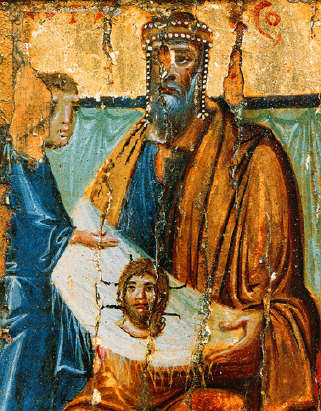A disciple of Christ sent by St. Thomas to the court of King Abgar the Black, the second century Osroene ruler. The historian Eusebius records this tradition, which he himself firmly believed to be historical and true. The tradition is also found in the book “The Teaching of Addaï,” which professes to belong to the Apostolic age.
The tradition states that Abgar, king of Edessa, afflicted with an incurable sickness, has heard the fame of the power and miracles of Jesus and writes to Jesus personally, praying Him to come and heal him. Jesus declines to travel to him, but promises to send a messenger, endowed with His power, namely St. Addal, one of the seventy-two Disciples.
The letter of correspondence as per tradition is as follows:
Abgar Ouchama to Jesus, the Good Physician Who has appeared in the country of Jerusalem, greeting:
I have heard of Thee, and of Thy healing; that Thou dost not use medicines or roots, but by Thy word openest (the eyes) of the blind, makest the lame to walk, cleansest the lepers, makest the deaf to hear; how by Thy word (also) Thou healest (sick) spirits and those who are tormented with lunatic demons, and how, again, Thou raisest the dead to life. And, learning the wonders that Thou doest, it was borne in upon me that (of two things, one): either Thou hast come down from heaven, or else Thou art the Son of God, who bringest all these things to pass. Wherefore I write to Thee, and pray that thou wilt come to me, who adore Thee, and heal all the ill that I suffer, according to the faith I have in Thee. I also learn that the Jews murmur against Thee, and persecute Thee, that they seek to crucify Thee, and to destroy Thee. I possess but one small city, but it is beautiful, and large enough for us two to live in peace.
When Jesus had received the letter, in the house of the high priest of the Jews, He said to Hannan, Agbar’s messenger and secretary, “Go thou, and say to thy master, who hath sent thee to Me:
‘Happy art thou who hast believed in Me, not having seen me, for it is written of me that those who shall see me shall not believe in Me, and that those who shall not see Me shall believe in Me. As to that which thou hast written, that I should come to thee, (behold) all that for which I was sent here below is finished, and I ascend again to My Father who sent Me, and when I shall have ascended to Him I will send thee one of My disciples, who shall heal all thy sufferings, and shall give (thee) health again, and shall convert all who are with thee unto life eternal. And thy city shall be blessed forever, and the enemy shall never overcome it.'”

An encaustic painting entitled Abgar [of Edessa] receiving the Mandylion
According to Eusebius, it was not Hannan who wrote answer, but Our Lord Himself. Hannan was also the archivist at Edessa and painter to King Abgar. He had been charged to paint a portrait of Our Lord, a task which he carried out. This image, which came to be known as the Mandylion, was one of the most celebrated relics in the east. The image was venerated in Constantinople up until 1204 when it disappeared during the sacking of the city during the Fourth Crusade.
St. Addal, bringing back with him to Edessa the picture and letter, cured Abgar and converted the king and his people to the faith. One of these was Addai, who became Addal’s successor. Addal is also supposed to have sent another disciple, Man, to various sites along the Tigris River. It is known that Addal did missionary work around Edessa toward the end of the second century. Both Addal and Man have been venerated in the Syrian and Persian churches since that era. Addal is recorded as a martyr for the faith.
Addai, became Addal's successor. Addal is also supposed to have sent another disciple, Man, to various sites along the Tigris River. It is known that Addal did missionary work around Edessa toward the end of the second century. Both Addal and Man have been venerated in the Syrian and Persian churches since that era. Addal is recorded as a martyr for the faith.
According to Christian tradition, the Mandylion also known as the Image of Edessa was a holy relic consisting of a square or rectangle of cloth upon which a miraculous image of the face of Jesus had been imprinted—the first icon ("image").
In the age of Eusebius, the original letters, written in Syriac, were thought to be kept in the archives of Edessa. At the present day we possess not only a Syriac text, but an Armenian translation as well, two independent Greek versions, shorter than the Syriac, and several inscriptions on stone.
Other Saints of the Day
St. Eusignius
St. Gormcal
St. Memmius
St. Nouna
St. Paris